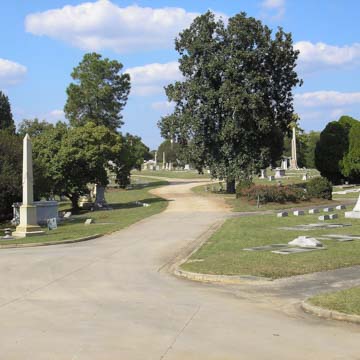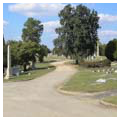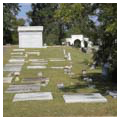Established in 1887, the rolling hills of Riverside Cemetery in Macon, Georgia, define a landscape that stands as an archetype of the late-nineteenth-century American cemetery. Designed by acclaimed landscape architect Calvert Vaux, the cemetery draws heavily from the tenets of the Picturesque: curving paths lead visitors through open fields defined by copses of mature trees to exciting views of the adjacent Ocmulgee River. The cemetery is only a few short blocks from downtown Macon and it contains more than 17,000 burial sites in its 125 acres.
Riverside Cemetery grew out of a public effort to revitalize Macon, a city languishing from a costly role in the Civil War. When writer Bret Harte visited Macon during this era, he noted the ghostly quality of the devastated city, describing the environment as tempered by “the resignations, the silence, the sweetness, the tenderness, of death.” By the end of the nineteenth century, citizens frustrated with the dilapidated state of Macon’s public spaces formed a coalition to establish a new public cemetery to honor the local deceased while simultaneously providing a park space they hoped would revive the city’s social life.
Prior to the war, Rose Hill Cemetery served as the city’s central burial ground. Created in the 1840s, Rose Hill was designed by and named after Simri Rose, an active member of Macon society, who fashioned the site as a garden-cemetery, modeled on Mount Auburn Cemetery in Massachusetts. Rose, an ardent student of horticulture, planted a wide range of regional trees and shrubs throughout the cemetery, which quickly became a public gathering space. Rose Hill suffered during the Civil War: locals complained that soldiers in a nearby encampment desecrated the grounds with rowdy behavior and bathing nude in the presence of mourners. It was also heavily used: more than 600 soldiers who died in local hospitals were buried at Rose Hill. Two decades after the end of the war, however, the cemetery was overgrown and neglected.
The new Riverside Cemetery was established directly adjacent to Rose Hill and Vaux clearly responded to Rose Hill in his design. At the time, Vaux had already completed several cemetery plans, including Trinity Cemetery in New York (1881) and Riverview Cemetery in Trenton, New Jersey (1887). In Macon, Vaux’s scheme reflects similar approaches, eschewing ornamentation and monumentality in favor of more naturalistic techniques that framed and sequenced the visitors’ experience of the landscape. Its roads are curvilinear but not exaggerated as they meander towards and along the Ocmulgee River. There, Vaux preserved an earthwork redoubt left on the site from the Civil War. Built by slave labor, the fortification had been set high on the bluff overlooking the Ocmulgee River to defend the city against potential attack from Union soldiers.
In 1897, six years after the cemetery was opened to the public, local architect Peter Dennis built a stately gatehouse that stands as a rare U.S. example of English half-timbered construction. In 1952, the city commissioned Ray Wyrick, a prominent cemetery designer, to expand Riverside onto a parcel north of the original site. Wyrick viewed cemeteries as a means of allowing the living to overcome grief through the experience of landscape, and he intended individual graves to be subsumed “into the peace of a quiet landscape.” The Riverside expansion provides an example of the lawn-park cemetery form, with areas in which the grave markers are flush with the ground. The lawn-park form offered unobstructed vistas and a more cost-effective, easily maintained site.
In 1966, Riverside Cemetery was dramatically bisected by the construction of I-75. The highway severed visitor access between the original cemetery and the northern expansion. Current efforts to expand I-75’s interchange with I-16, just east of the cemetery, have prompted resistance from local residents who are working to protect the historic landscape. Despite this threat, Riverside Cemetery remains a destination for locals and tourists. Only a few blocks from downtown Macon, the cemetery offers a central greenspace in the city. Macon’s new mixed-use Ocmulgee Heritage Trail passes through the cemetery and connects the site to other significant places throughout the city. The Historic Riverside Cemetery Conservancy was established in 2007 to oversee the preservation of the historic landscape. A new master plan is underway to guide the future management of the cemetery.
References
Georgia Department of Transportation. 4 th Addendum to the Assessment of Effects: GDOT Projects NHIM0-0016-01(092), NHIM0-0016-01(131), NHIM0-0075-02(177), NH000-0016-01(104).Atlanta, GA: Department of Environmental Services, 2014.
Iobst, Richard W. Civil War Macon: The History of a Confederate City.Macon: Mercer University Press, 2009.
Kowsky, Francis R. Country, Park and City: The Architecture and Life of Calvert Vaux.New York: Oxford University Press, 2003.
Riverside Cemetery and Conservancy. “History of Riverside Cemetery.” Accessed February 27, 2017. http://www.riversidecemetery.com/history/.




